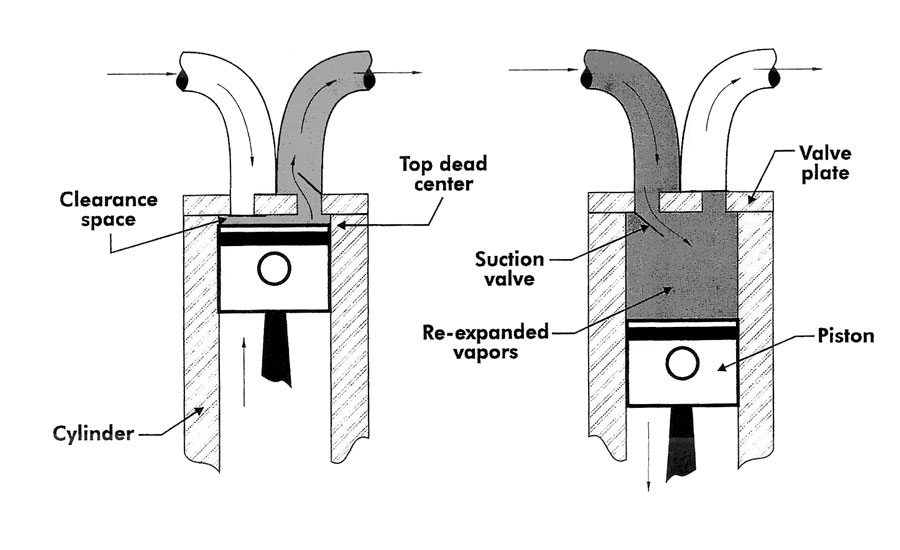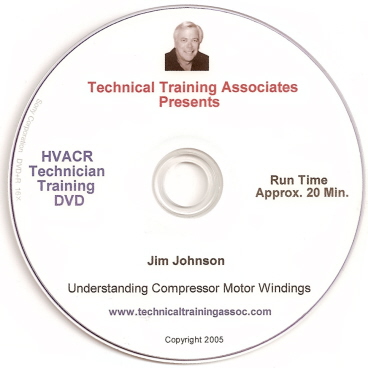The capacity of a compressor can be affected by a refrigeration system’s ever-changing pressures. In addition, suction pressure entering the compressor will change the density of the suction gasses within the compressor and affect its capacity. The temperature of the refrigerant entering the compressor’s cylinder also has an effect on capacity, but for this article, we’ll focus on pressures.
COMPRESSION RATIOS
Both the high- and low-side system pressures can be expressed as a ratio called a compression ratio. Compression ratio is defined as the absolute discharge pressure divided by the absolute suction pressure.
Compression Ratio = Absolute discharge pressure/Absolute suction pressure
Most technicians realize their service gauges read zero when not connected to a system, even though there is a pressure of approximately 15 psi on the gauges exerted from atmospheric pressure. These gauges are calibrated to read zero at atmospheric pressure. Therefore, in order to use the true or “absolute” discharge and suction pressure at zero gauge pressure or above, a technician must add approximately 15 psi (14.696 psi) to the gauge reading.
When referring to absolute pressure, psia is used to label the pressure’s magnitude, and psig labels the pressure’s magnitude when referring to gauge pressure. Any time pressures are used in a mathematical equation, the true or “absolute” pressure must be used or the calculated answer will be meaningless.
Here is an example of a compression ratio calculation:
Discharge pressure = 145 psig
Suction pressure = 5 psig
Compression ratio = absolute discharge pressure/absolute suction pressure
Absolute discharge pressure = gauge reading + 15 psi
Absolute suction pressure = gauge reading + 15 psi
Compression ratio =
(145 psig + 15 psi)/(5 psig + 15 psi) =
160 psia = 8 or (8 to 1)/20 psia
A compression ratio of 8:1 simply means the discharge pressure is eight times the magnitude of the suction pressure.
DENSITY ENTERING THE CYLINDER
A refrigeration system’s pressures can dictate how much refrigerant will flow through the system. If the pressure of the suction line that delivers refrigerant gas to the compressor cylinders is high, the density of refrigerant vapors will be high and the mass flow rate of refrigerant will be high. On the other hand, if the pressure of the suction line is low, the density of the refrigerant vapors will be lower and the refrigerant flow rate will be lower.
When you fill a fixed volume (such as a compressor’s cylinder) with a higher pressure, more refrigerant gas molecules will be present, causing a higher refrigerant density inside the cylinder. The mass flow rate of refrigerant through the compressor is a product of the piston displacement and the density of the refrigerant filling the cylinder. Here is the equation:
Mass flow rate (pounds/minute) = piston displacement (cubic feet/minute) x refrigerant density (pounds/cubic foot)
THE DISCHARGE AND SUCTION STROKES
Now that we know how to calculate a compression ratio, let’s dig a bit deeper into what compression ratio physically means when applied to a cooling system.
In reciprocating compressors, there must be some clearance space between the piston at top dead center and the valve plate, otherwise there would be a collision of the two. This intentionally designed clearance volume or clearance pocket traps a certain amount of refrigerant vapor after the discharge valve closes. Even though compressor manufacturers are reducing the amount of clearance volume found between the valve plate and piston head, some clearance will always remain.
The clearance volume gas pressure is assumed to be at the discharge pressure if we ignore valve weight and valve spring forces. The vapor left in the clearance volume has been compressed to the discharge pressure. Once the down stroke of the piston starts, this same clearance volume vapor must be re-expanded to just below the suction pressure before the suction valve can open and let new vapors into the cylinder.
The piston, however, will have already completed part of its suction stroke and the cylinder will already have been filled with re-expanded clearance vapors from the clearance volume before new vapors enter. These re-expanded clearance volume vapors take up valuable space that new suction vapors coming from the suction line cannot occupy. Hence suction vapors from the suction line will fill only the part of the cylinder volume that is not already filled with re-expanded discharge gases. Therefore, the total volume of the piston’s cylinder is not completely utilized in taking in new refrigerant gases, and the system is said to have a volumetric efficiency.
VOLUMETRIC EFFICIENCY
Volumetric efficiency is expressed as a percentage from 0-100 percent depending on the system in question. Volume efficiency is defined as the ratio of the actual volume of the refrigerant gas pumped by the compressor to the volume displaced by the compressor pistons.
A high volumetric efficiency means that more of the piston’s cylinder volume is being filled with new refrigerant from the suction line and not re-expanded clearance volume gases. The higher the volumetric efficiency, the greater the amount of new refrigerant that will be introduced into the cylinder each down stroke of the piston, and thus more refrigerant will be circulated with each revolution of the crankshaft. The system will now have better capacity and a higher efficiency. So, the lower the discharge pressure, the less re-expansion of discharge gases to suction pressure. Also, the higher the suction pressure, the less re-expansion of discharge gases, because of the discharge gases experiencing less re-expansion to the higher suction pressure and the suction valve will open sooner.
A service technician can control, to a certain extent, how high or low the discharge and suction pressure will get. If the discharge (condensing) pressures can be kept low and the suction (evaporating) pressure can be kept as high as possible without affecting the refrigerated product temperature, the compression ratio will be low and the volumetric efficiency will be high. This will cause a higher mass flow rate of refrigerant to flow through the compressor and system.
There are some common causes for low suction pressure and/or high head pressure which can be controlled by a service technician.
Causes for low suction (evaporating) pressures:
- Evaporator fan out;
- Iced evaporator coil;
- Dirty evaporator coil;
- Defrost time clock faulty;
- Not enough programmed defrosts;
- Defrost heater bad;
- Undercharge of refrigerant;
- Low case heat load; and
- High humidity load on coil causing excessive frost.
Causes for high head (condensing) pressures:
- Dirty condenser;
- Overcharged system;
- Condenser fan out;
- Recirculated air over the condenser;
- Undersized condensing unit;
- High ambient;
- Non-condensable (air) in the system; and
- High case humidity or heat load.
Publication date: 8/7/2017
Want more HVAC industry news and information? Join The NEWS on Facebook, Twitter, and LinkedIn today!










